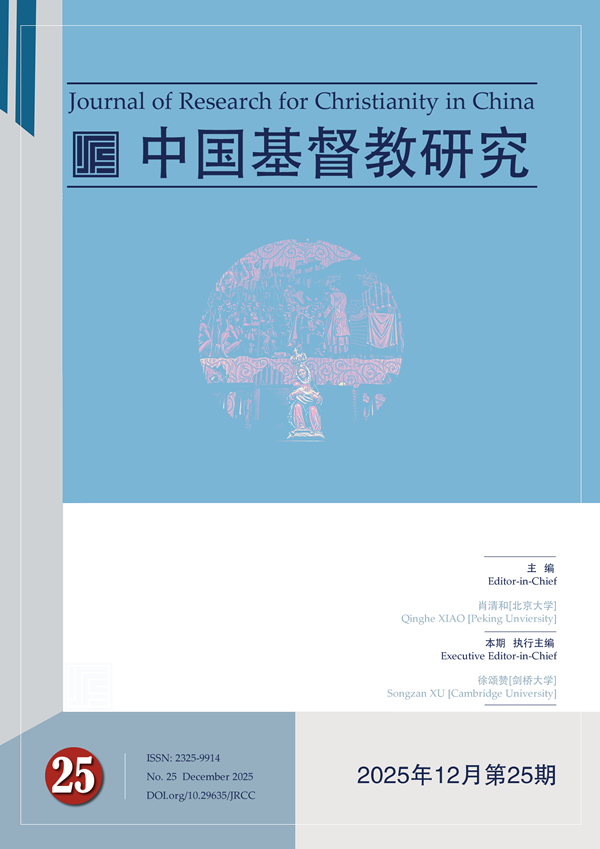Abstract
This article explores the adaptive interpretation of creatio ex nihilo by Ludovico Buglio in his translation of St. Thomas Aquinas’ Summa Theologiae I, Q45, A1 (corresponding to ChaoXingXueYao, CXXX, Section I.3, Chapter 10.2.1). By analyzing Buglio’s textual structural adaptations and terminological choices, this study highlights his strategies for bridging Western theological concepts with Chinese cultural frameworks. The primary findings reveal that Buglio employs the Confucian term HuaCheng (化成) to translate creatio and creare, emphasizing the dynamic process of creation while adjusting the content’s organization in accordance with Ming-Qing literary conventions. His translation prioritizes readability for Chinese audiences, striking a balance between fidelity to Aquinas’s arguments and cultural adaptation. Furthermore, Buglio’s work exemplifies the early Jesuits’ efforts to negotiate theological terminology across cultural boundaries, striving to construct “equivalence relations” between Latin-Christian and Chinese philosophical terms amidst linguistic and philosophical tensions. These “equivalence relations” not only facilitated the dissemination of Christian theology in China but also provide methodological insights for the development of Sino-Christian theology in terms of translation and hermeneutics.
References
Brockey, Liam Matthew. Journey to the East: the Jesuit mission to China, 1579-1724. Cambridge: Harvard University Press, 2007.
Garrigou-Lagrange, Reginald. The Trinity and God the Creator: A Commentary on St. Thomas' Theological Summa. Translated by Frederic C. Eckhoff. St. Louis: B. Herder, 1952.
Ge, Yonghua. “Creatio ex nihilo and Ancient Chinese Philosophy: A Revisiting of Robert Neville's Thesis”, in Philosophy East and West, Volume. 68, No. 2. Honolulu: University of Hawai'i Press, 2018, pp. 352-370.
Herbermann, Charles George, et al. The Catholic encyclopedia: an international work of reference on the constitution, doctrine, discipline, and history of the Catholic Church. Volume 9. New York: R. Appleton, 1910.
Holy See. “Aeterni Patris (Encyclical of Pope Leo XIII): On the Restoration of Christian.” Accessed Sept 9, 2025. https://www.vatican.va/content/leo-xiii/en/encyclicals/documents/hf_l-xiii_enc_04081879_aeterni-patris.html.
Jakobson, Roman. On Linguistic Aspects of Translation. Edited by Reuben Arthur Brower. On Translation. Cambridge: Harvard University Press, 1959.
Lackner, Michael. "Some Preliminary Remarks on the First Chinese Translation of Thomas Aquinas’ Summa theologica", in Geschichte Der Germanistik, No. 53/54. Göttingen: Wallstein, 2018, pp. 53-54.
LIM, Ji-Min. "A Translation Study on Chaoxingxueyao (超性學要), the First Chinese Translation of Thomas Aquinas' Summa Theologiae-Focusing on Cultural Translation revealed in the Problem of Evil". In Korea Presbyterian Journal of Theology, Volume 55, No. 4. Seoul: Presbyterian College and Theological Seminary Press, 2023, pp. 93-120.
MEYNARD, Thierry. "A Thomistic Argumentation on Creationism in Late Ming China: First Juan of the Explanation on the Great Being (Huanyou Quan), 1628”, in International Philosophical Quarterly, Volume 62, No. 3. New York and Namur: Fordham University and Université de Namur, 2022, pp. 319-334.
Silva, Ignacio. “Thomas Aquinas and William E. Carroll on Creatio ex Nihilo: A Response to Joseph Hannon’s ‘Theological Objections to a Metaphysicalist Interpretation of Creation’”. In Theology and Science, Volume 19, No. 2. 2021, pp. 91-99. doi:10.1080/14746700.2021.1910908.
St. Thomas Aquinas. Summa Theologiae. vol. 8, Translated by Thomas Gilby et al. New York: Cambridge University Press, 1967.
Tertullian. Adversus Hermogenem. Translated and annotated by J. H. Waszink. Ancient Christian Writers 24. Westminster and London: Newman Press and Longmans,Green and CO. 1956.
方豪。《中国天主教史人物传(中)》。北京:中华书局,1988。[FANG, Hao. Biographies of Figures in the History of Catholicism in China (Middle Volume). Beijing: Zhonghua Book Company, 1988.]
何光滬。《漢語神學的根據與意義》。载《維真學刊》第2期(总卷期009)。温哥华:維真學院中國研究部,1996,第39-47页。[HE, Guanghu. “The Foundation and Significance of Chinese Theology.” In Regent Chinese Journal, No. 2 (Total Issue 009). Vancouver: Regent College Chinese Study Program, 1996, pp. 39-47.]
胡文婷。《〈神学大全〉入华初探》。载《国际汉学》第1期。北京:外语教学与研究出版社出版,2017,第65-71页。[HU, Wenting. “A Brief Study of Summa Theologiae in China”. In International Sinology, No.1. Beijing: Foreign Language Teaching and Research Press, 2017, pp. 65-71.]
胡文婷。《清初西学东渐的代表性著作: 〈超性学要〉——清宫传教士利类思的翻译浅谈》。载《北京行政学院学报》第3期。北京:北京行政学院学报,2017年,第123-128页。[HU, Wenting. “Summa Theologica (Chaoxingxue Yao), a Representative Work of the Eastward Dissemination of Western Learning in the Early Qing Dynasty: A Brief Study of Translation Strategy of Ludovico Buglioas a Jesuit Missionary in Oing Imperial Court”. In Journal of Beijing Administrative College, No.3. Beijing: Journal of Beijing Administrative College, 2017, pp. 123-128.]
井上哲次郎等. 哲学字彙: 英独仏和. Tokyo: 丸善株式會社, 1912. [INOUYE, Tetsujiro. Dictionary of English, German, and French Philosophical Terms with Japanese Eouivalents. Tokyo: The Maruzen Kabushiki- Kaisha, 1912.]
柯昊。《文化学视域下的“化成”论研究》。载《江西社会科学》第12期。江西:江西省社会科学院,2022,第189-195页。[KE, Hao. “A Study on the Theory of Enlightenment from the Perspective of Culturology”. In Jiangxi Social Sciences, No. 12. Jiangxi: Jiangxi Academy of Social Sciences, 2022, pp. 189-195.]
雷立柏。《汉语神学术语词典:拉丁-英-汉语并列》。北京:宗教文化出版社,2007。[LEI, Libo. A Dictionary of Theological: TermsLatin - English - Chinese. Beijing: Religious Culture Publishing House, 2007.]
林珊妏。《〈超性學要〉論「邪魔」之罪與惡研究—與中文版〈神學大全〉比對為主》。载《國立彰化師範大學文學院學報》第29期。台湾:國立彰化師範大學文學院,2024,第27-48页。[LIN, Shanwen. “A Study of 'Sin' and 'Evil' Concerning 'Demons' in Chaoxingxueyao -- A Comparison with the Chinese Version of Summa Theologica”. In NCUE Journal of Humanities, No. 29. Taiwan: College of Liberal Arts, National Changhua University of Educafion, 2024, pp. 27-48.]
丘濬。《大学衍义补》第3册。郑州:中州古籍出版社,1995。[QIU, Jun. Daxue Yanyi Bu, Volume. 3. Zhenzhou:Zhongzhou Ancient Books Publishing House, 1995.]
沈国威。《汉语近代二字词研究:语言接触与汉语的近代演化》。上海:华东师范大学出版社,2019。[SHEN, Guowei. A Study of Modern Disyllabic Words in Chinese: Language Contact and the Modern Evolution of Chinese. Shanghai: East China Normal University Press, 2019.]
实藤惠秀著,谭汝谦、林启彦译。《中国人留学日本史》。北京:生活·读书·新知三联书店,1983年。[SANETO, Keishu. A History of Chinese Students in Japan. Translated by TAN, Ruqian and LIN Qiyan. Beijing: SDX Joint Publishing Company, 1983.]
托马斯·阿奎那著,段德智译。《神学大全》(第1卷)。北京:商务印书馆,2013。[Thomas Aquinas. Summa Theologiae, Volume. 1. Translated by DUAN, Dezhi. Beijing: The Commercial Press, 2013.]
托马斯·阿奎那著,段德智译。《神学大全》(第2/3卷)。北京:商务印书馆,2013。[Thomas Aquinas. Summa Theologiae, Volume. 2/3. Translated by DUAN, Dezhi. Beijing: The Commercial Press, 2013.]
肖祥劍编。《周易》。北京:团结出版社,2014。[XIAO Xiangjian, ed. I Ching (Book of Changes). Beijing: Unity Press, 2014.]
张西平等编。《梵蒂冈图书馆藏明清中西文化交流史文献丛刊(第30册)》。郑州:大象出版社,2014。[Federico Masini, ed. Collectanea of Historical Documents on Cultural Exchange between China and the West from the Ming and Qing Dynasties Held in the Vatican Library (Volume. 30). Zhengzhou: Elephant Press, 2014.]
周伟驰。《奥古斯丁在中国(第一册:研究篇)》。北京:宗教文化出版社,2024。[ZHOU, Weichi. Augustine in China (Vol. 1: Studies). Beijing: China Religious Culture Publisher, 2024.]
周伟驰。《基督教经典译介中的“中国化”传统》。《上海市社会主义学院学报》第4期。上海:上海市社会主义学院学报杂志出版社,2023,第35-44页。[ZHOU, Weichi. "The 'Sinicization' Tradition in the Translation of Christian Classics." In Journal of Shanghai Institute of Socialism, No. 4. Shanghai: Shanghai Institute of Socialism Journal Press, 2023, pp. 35-44.]
朱熹。《原本周易本义(钦定四库全书)》。北京:中国书店,2015。[ZHU, Xi. Original Meaning of the Zhou Yi (The Imperial Catalog of the Four Treasuries Edition). Beijing: China Books, 2015.]
卓新平。《中国基督教》。北京:中国社会科学出版社,2021。[ZHUO, Xinping. Christianity in China. Beijing: China Social Sciences Publishing House, 2021.]
《圣经:创世纪》(和合本),1: 1、1: 31。[The Bible: Genesis (Chinese Union Version), 1:1, 1:31.]
《圣经:玛加伯下》(思高本),7:28。[The Bible: 2 Maccabees (Studium Biblicum Version), 7:28.]

This work is licensed under a Creative Commons Attribution-NonCommercial-NoDerivatives 4.0 International License.

